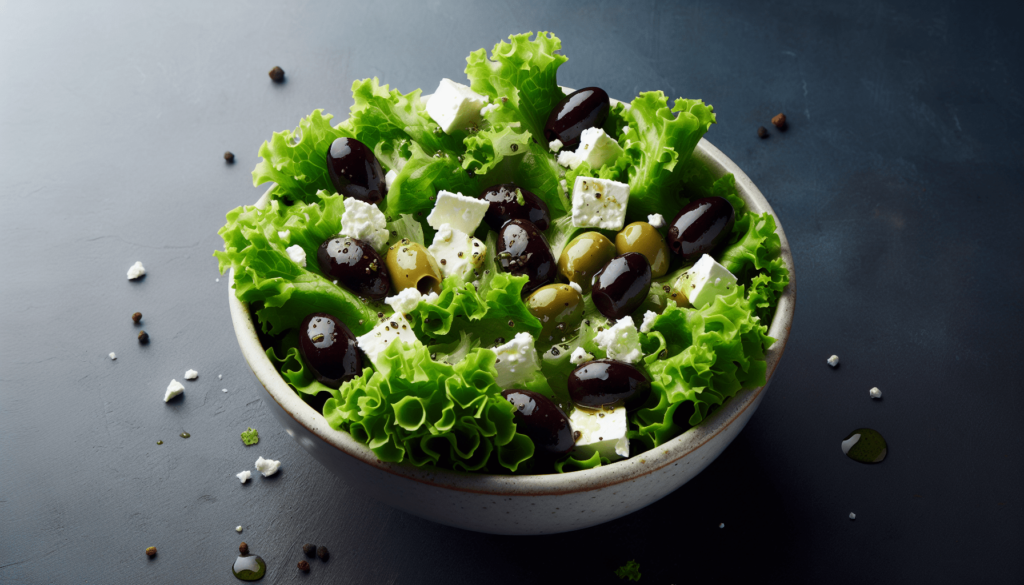Embark on a flavorful journey that marries the zest of the Mediterranean with the healthful essence of Keto in the “Keto Mediterranean Salad with Olives and Feta” recipe. This dish not only tantalizes your taste buds with its savory olives and creamy feta but also aligns perfectly with your low-carb objectives, embracing the added benefits of fermented foods for an optimized gut health experience. Perfect for anyone looking to infuse their keto lifestyle with a holistic, tantalizing twist, this guide offers recipes and invaluable tips to elevate your culinary adventure.

Understanding the Keto Mediterranean Diet
Overview of the Keto Diet
The Keto diet is a high-fat, low-carbohydrate eating plan designed to put your body into a metabolic state known as ketosis. In ketosis, your body efficiently burns fat for energy instead of relying on carbohydrates. By significantly reducing carb intake and focusing on healthy fats and proteins, the Keto diet can help you lose weight and potentially improve certain health markers like blood sugar and cholesterol levels.
The Mediterranean Influence on Keto
Incorporating the Mediterranean diet’s principles into the Keto lifestyle adds a refreshing and nutritious twist. The Mediterranean diet is renowned for its emphasis on whole foods, such as fruits, vegetables, nuts, seeds, olive oil, and fish. It’s a diet pattern that promotes heart health and is associated with a reduced risk of chronic diseases. The Keto Mediterranean diet merges the best of both worlds, focusing on high-fat, low-carb foods while incorporating the rich, flavorful, and nutrient-dense ingredients typical of Mediterranean cuisine.
Benefits of Combining Keto with Mediterranean Elements
This fusion offers several benefits, including increased dietary variety, enhanced flavor profiles, and a broader spectrum of nutrients. It emphasizes the consumption of quality fats and proteins while providing ample fiber and antioxidants through a generous portion of vegetables and select fruits that are low in carbs and high in nutrients. This combination can lead to greater satisfaction with meals, improved heart health, and sustained weight management.
Key Ingredients in a Keto Mediterranean Diet
Key ingredients include healthy fats like olive oil, avocados, and nuts; lean proteins such as fish, chicken, and eggs; low-carb vegetables like leafy greens, zucchini, and broccoli; and moderate amounts of cheese and yogurt. Fresh herbs and spices also play a significant role in flavoring dishes without adding extra carbs.
The Role of Olives and Feta
Nutritional Profile of Olives
Olives are a staple in the Mediterranean diet, rich in healthful fats—specifically monounsaturated fats—and packed with antioxidants. They’re low in carbs but high in fiber, making them an excellent snack or addition to meals for those on a Keto diet.
Health Benefits of Feta Cheese
Feta cheese, traditionally made from sheep’s milk or a mixture of sheep and goat’s milk, brings a tangy flavor and creamy texture to dishes. It’s a good source of calcium, B vitamins, and beneficial fatty acids while being lower in calories and fat than some other cheeses, making it a keto-friendly option for adding richness and flavor.
How Olives and Feta Enhance Keto Diets
Incorporating olives and feta into Keto diets adds a burst of flavor and a host of nutritional benefits. The fats in olives are satiating, helping to curb hunger, while the unique taste and texture of feta cheese can make even the simplest dish feel indulgent. Together, they contribute healthy fats, protein, and essential nutrients, making meals more satisfying and balanced.
Varieties of Olives and Feta to Consider
Explore the wide range of olive and feta varieties to keep your meals exciting. Different types of olives (Kalamata, Manzanilla, Castelvetrano) offer distinct flavors and textures. Similarly, feta can range from soft and mild to crumbly and tangy. Experimenting with these varieties can bring new tastes and interest to your Keto Mediterranean diet.
Ingredients Needed for Keto Mediterranean Salad
Detailed List of Ingredients
For a refreshing Keto Mediterranean salad, gather the following ingredients: mixed leafy greens (such as spinach, arugula, and romaine), cherry tomatoes, cucumber, red onion, Kalamata olives, avocado, feta cheese, and extra virgin olive oil. Not only is this combination flavorful, but it also offers a rich mix of vitamins, minerals, and healthy fats.
Choosing the Right Type of Olives and Feta
Opt for olives that are brined in water and salt rather than oils or vinegars to keep the salad authentic and keto-friendly. For feta, choose a block that you can crumble yourself to ensure freshness and avoid added starches or preservatives found in pre-crumbled varieties.
Optional Ingredients for Added Flavor
Consider adding thinly sliced radishes, bell peppers, or artichoke hearts for extra crunch and flavor. Fresh herbs like basil, dill, or oregano can also enhance the salad’s aroma and taste profile.
Ingredients to Avoid to Maintain Ketosis
Stay away from high-carb vegetables like potatoes, corn, and peas, as well as sweetened dressings or marinades. Stick to whole, unprocessed ingredients to maintain ketosis and ensure your salad aligns with Keto principles.
Preparing the Salad
Step-by-Step Preparation Guide
Start by washing and drying your leafy greens and vegetables. Slice the cucumber, cherry tomatoes, red onion, and avocado. Crumble the feta cheese and pit the olives if necessary. Layer the greens at the base of your salad bowl, followed by the prepared vegetables, olives, and feta cheese on top.
How to Cut and Prepare Vegetables
Aim for uniformity in your cuts to ensure each bite is balanced. Thinly slice cucumbers and onions for a subtle crunch and mild flavor. Halve cherry tomatoes and scoop or slice avocados just before serving to prevent browning.
Mixing the Dressing
In a separate bowl, whisk together extra virgin olive oil, lemon juice, salt, and pepper for a simple but flavorful dressing. Adjust the quantities to suit your taste preferences.
Combining Ingredients for Optimal Flavor
Drizzle the dressing over the salad just before serving to keep the vegetables crisp. Gently toss to ensure every ingredient is lightly coated for a harmonious blend of flavors.

Dressing for Keto Mediterranean Salad
Keto-Friendly Salad Dressing Options
Besides the classic olive oil and lemon juice dressing, you can experiment with other keto-friendly options like creamy avocado dressing or a tangy vinaigrette made with apple cider vinegar and a hint of mustard.
How to Make a Simple Olive Oil Dressing
Combine three parts extra virgin olive oil to one part lemon juice. Season with salt, pepper, and a teaspoon of Dijon mustard for extra depth. Whisk until emulsified.
Adjusting the Dressing to Your Taste
Feel free to add minced garlic, dried herbs, or a sprinkle of Parmesan cheese to your dressing for added complexity.
Storage Tips for Dressing
Store any leftover dressing in an airtight container in the refrigerator for up to a week. Remember to give it a good shake or whisk before using it again to recombine the ingredients.
Nutritional Information
Macronutrient Breakdown
This Keto Mediterranean salad is high in healthy fats, moderate in protein, and low in carbohydrates. The majority of the carbs come from vegetables and are offset by a high fiber content, which is beneficial for maintaining ketosis.
Understanding Net Carbs
Net carbs are total carbohydrates minus the fiber content. This is an important concept in the Keto diet as it represents the actual number of carbs that will impact your blood sugar levels. The fiber from vegetables in this salad helps to lower the net carb count, making it suitable for a Keto lifestyle.
Vitamins and Minerals in the Salad
Enjoy a wealth of vitamins and minerals from this salad, including vitamin C from tomatoes, potassium from avocados, calcium from feta, and antioxidants from olives.
Energy Content and Serving Size
Given the high-fat content, this salad is relatively calorie-dense, providing sustained energy. Be mindful of portion sizes based on your individual energy needs and Keto macro goals.

Serving Suggestions
Pairing with Keto-Friendly Main Dishes
This salad pairs beautifully with grilled meats, fish, or poultry for a complete Keto meal. It also works well as a standalone dish for a light lunch or appetizer.
How to Present the Salad for Guests
Layer the ingredients artfully in a clear salad bowl for a vibrant display. Consider serving the dressing on the side for guests to add to their liking.
Portion Sizes and Meal Timing
Aim for moderate portions if enjoying the salad as a side or appetizer. If it’s your main dish, feel free to indulge in a larger serving. This salad is perfect for any mealtime, offering a refreshing option that’s both satisfying and nutritious.
Adding Protein Sources for a Complete Meal
Top the salad with grilled chicken, seared tuna, or hard-boiled eggs to add a protein boost, making it a more substantial meal.
Variations of Keto Mediterranean Salad
Incorporating Different Proteins
Beyond chicken or fish, consider adding cooked shrimp, anchovies, or even crispy bacon for a different flavor profile and textural contrast.
Exploring Various Cheese Options
While feta is traditional, goat cheese, shaved Parmesan, or chunks of blue cheese can offer new tastes and enrich the overall experience of the salad.
Adding Low-Carb Vegetables for Variation
Experiment with adding asparagus, green beans, or roasted red peppers to introduce new flavors and increase the nutritional value of the salad.
Seasonal Adaptations of the Salad
Adjust the ingredients based on seasonal availability. In the summer, incorporate fresh basil and ripe tomatoes; in the cooler months, opt for roasted vegetables and hearty greens.

Storage and Leftovers
How to Store the Salad
If you have leftover salad, store it in an airtight container in the refrigerator. Keep the dressing separate to prevent the greens from wilting.
What to Do with Leftover Salad
Enjoy leftover salad within a day for best quality. Consider repurposing it as a filling for an omelet or topping for a keto-friendly pizza if the greens aren’t as crisp.
Refreshing a Stored Salad Before Serving
If the salad seems a bit lackluster, give it new life with a fresh squeeze of lemon juice or a drizzle of olive oil before serving.
Freezing Components of the Salad
While freezing the prepared salad isn’t recommended due to texture changes upon thawing, you can freeze individual ingredients like olives and feta for future use. Just be aware that the texture might slightly change.
FAQs on Keto Mediterranean Salad with Olives and Feta
Addressing Common Questions about the Recipe
- Can I use bottled lemon juice? Fresh is best for flavor and nutrients, but in a pinch, bottled can work.
- Is this salad gluten-free? Yes, as long as all your ingredients are naturally gluten-free and free from cross-contamination.
Modifications for Specific Dietary Needs
To adapt the salad for dairy-free diets, omit the feta or use a dairy-free cheese alternative. For those watching their sodium intake, choose low-sodium olives and cheese.
How Often to Include This Salad in Your Diet
Given its nutritious profile and alignment with Keto principles, this salad can be a regular part of your meal rotation. Just ensure you’re also incorporating a variety of other foods to meet all your nutritional needs.
Tips for Beginners on the Keto Mediterranean Diet
Start simple by focusing on whole, unprocessed foods and paying attention to carb counts. Experiment with flavors and ingredients within the Keto Mediterranean framework to keep meals exciting and satisfying.
This Keto Mediterranean Salad with Olives and Feta exemplifies how you can enjoy sumptuous, nutritious meals that support your health goals without sacrificing flavor or variety. Enjoy it as a way to refresh your eating habits, explore new culinary horizons, and nourish your body with what it needs to thrive on a Keto diet.

